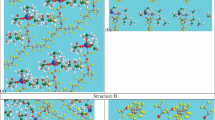Abstract
Geometrical and energetic characteristics of crystal hydrates of individual aromatic sulfonic acids and their complexes with poly(vinyl alcohol) as well as the paths for the proton transport in them are calculated in the framework of the density functional theory (version B3LYP) employing the 6-31G** basis set. The energy of attachment of water to ortho-substituted aromatic sulfonic acids is demonstrated to diminish from 74.4 to 54.8 kJ mol−1 in the following series of substituents: -OH,-F,-CH3,-H,-Cl, and -COOH. For the dimers that comprise individual phenolsulfonic acids, the energy of attachment of one water molecule to the SO3H group is estimated to be equal to 92–105 kJ mol−1. In the dimers comprising individual phenolsulfonic acids, the specific energy of intermolecular bonds (bond energy per monomer molecule) is found to be equal to 49.3 and 58.5 kJ mol−1 for, respectively, phenol-2,4-disulfo and phenol-2-sulfo acids. During the formation of polymer membranes based on poly(vinyl alcohol) and phenolsulfonic acids, it is energetically favorable that at least one water molecule should remain in the vicinity of the SO3H fragment. According to the calculations, the proton migration along the SO3H group in anhydrous environment is hampered by a barrier of 125–132 kJ mol−1. In the presence of water, the proton conductivity is of a relay character, with an activation barrier equal to 21–33 kJ mol−1. The latter value is close to experimental data (17–25 kJ mol−1).
Similar content being viewed by others
References
Aldoshin, S.M., Dobrovolsky, Yu.A., and Tarasov, B.P., Abstracts of Papers, Mezhd. forum “Vodorodnye tekhnologii dlya proizvodstva energii” (Int. Forum on Hydrogen Technologies for Production of Energy), Feb 6–10, 2006, Moscow: ANO Rusdem-Energoeffekt, 2006, p. 128.
Dobrovolsky, Yu.A., Volkov, E.V., Pisareva, A.V., Fedotov, Yu.A., Likhachev, D.I., and Rusanov, A.L., Ross. Khim. Zh. 2006, vol. 50, no. 6, p. 95.
Dobrovolsky, Yu.A., Pisareva, A.V., Leonova, L.S., and Karelin, A.I., Altern. Energ. Ekol., 2004, no. 12, p. 36.
Weng, N.S., Acta Crystallogr., Sect. C: Cryst. Struct. Commun., 1997, vol. 53, p. 633.
Taga, T. and Kobayashi, T., Acta Crystallogr., Sect. C: Cryst. Struct. Commun., 1990, vol. 46, p. 2243.
Arora, S.K. and Sundaralingam, M., Acta Crystallogr., Sect. B: Struct. Sci., 1971, vol. 27, p. 1293.
Becke, A.D., J. Chem. Phys., 1993, vol. 98, p. 5648.
Gaussian 03, Pittsburg (PA): Gaussian, Inc., 2003, revision B.03.
Bukun, N.G., Ukshe, A.E., and Ukshe, E.A., Elektrokhimiya, 1993, vol. 29, p. 110.
Pisareva, A.V., Shilov, G.V., Karelin, A.I. and Dobrovolsky, Yu.A., Zh. Fiz. Khim. (in press).
Author information
Authors and Affiliations
Corresponding author
Additional information
Original Russian Text © T.S. Zyubina, A.V. Pisareva, Yu.A. Dobrovolsky, A.S. Zyubin, G.A. Pokatovich, I.S. Irgibaeva, S.K. Lin, A.M. Mebel’, 2007, published in Elektrokhimiya, 2007, vol. 43, No. 5, pp. 528–539.
Based on the paper delivered at the 8th Meeting “Fundamental Problems of Solid-State Ionics”, Chernogolovka (Russia), 2006.
Rights and permissions
About this article
Cite this article
Zyubina, T.S., Pisareva, A.V., Dobrovolsky, Y.A. et al. Modeling the hydration and proton transport in solid electrolytes based on phenolsulfonic acids. Russ J Electrochem 43, 502–512 (2007). https://doi.org/10.1134/S1023193507050023
Received:
Issue Date:
DOI: https://doi.org/10.1134/S1023193507050023



